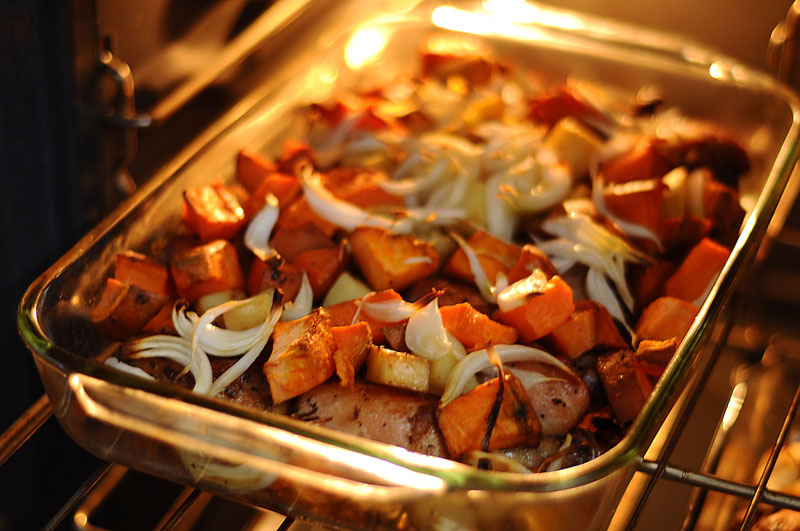This post tackles another couple terms that are often confused: roast and braise. I’m focusing on meat, though coffee and chocolates also fit in the roasting category. Most of the time you’ll hear of people roasting meats instead of braising them, but every once in a while you hear the word ‘braise’ come up, and your brain shifts into librarian mode, sifting through the different inner-recess indices, “I’ve heard that word before… braise… now what is that?” Instead of digging around for that old file, let’s create a new one (honestly, both of these terms deserve their own entries).
To Roast…

Roasting is cooking with dry heat, and usually in the oven, though the oven is not required. You can also roast something on a spit over the fire, or surround the food with hot embers, stones, or sand. The primary concept of roasting is dry heat, in other words, no liquid added.
The best roasting occurs with larger, tender meat cuts or poultry because they’re relatively moist. Some popular types of roasts are chicken roast, chuck roast, roast pork loin, sirloin tip roast, bottom round roast, and top round roast. These are often accompanied by potatoes, onions, and carrots (most root and bulb vegetables can be roasted). Tougher meats require moist cooking methods like braising. Keep in mind that when oven roasting, the pan is left uncovered which causes the meat to nicely brown (often caramelizes the meat’s surface) on the outside and stay moist on the inside. Anytime you cook meat (or vegetables) via the roasting method, the dish is referred to as “roast,” for example, roast turkey or roasted potatoes. As a side note, if you’re roasting vegetables, I would advise basting the vegetables with a butter or oil marinade to prevent them from losing too much moisture.
You can roast meat on any temperature, but the higher the temperature, the quicker the moisture escapes the meat. For larger meats, keep the oven temperature low (~275 degrees F) so that the meat will stay tender and cook all the way through. For small meat cuts, roasting at a high temperature can be beneficial so that the meat cooks without losing all its moisture.
Before roasting meat, I like to season it with salt and pepper (and sometimes other seasonings) and then brown it in a frying pan with oil. This gives the meat extra flavor and gives it a nice, traditional brown color when it’s done being roasted.
…or to Braise
Braising is cooking with a combination of moist and dry heat in a covered pot. This works best for tough meats because the added moisture helps break down the tough connective tissues and collagen in the meat. Often people like to add vegetables and other ingredients when braising meats because the ingredients interact and create a delicious, flavorful meal. (I particularly like onions in mine.)
The key to braising is adding the right amount of liquid so that the moisture and heat continue working together to tenderize the meat. I typically add 1-1/2″ liquid in the bottom of the pan. The liquid from the meats and vegetables contribute liquid volume as the meal cooks. For best flavoring, use liquids that contribute to the meat’s flavor, such as Worcestershire sauce, broths, or tomato juice. Because braising is a mixture of temperature, time, moisture, you’ll achieve the best results by cooking your meat for longer periods of time (the liquid should remain at a simmer throughout the braising process) and at a low to mid temperature (325-375 degrees F). As with roasting, I like to season and sear my meats before braising them. This is almost always done when braising.
You know your meat is cooked when it easily separates with just a fork. After the meat is cooked, you can use the leftover liquid as a gravy or sauce for your meats and vegetables. (Hint, the less liquid you use while braising your meat, the more intensely flavored the leftover liquid will be.)
—-
Do you have a favorite roasting or braising recipe? Or do you have any additional advice? Please share it in the comments below.

Hey, when are we going to get the recipe for giant hamdogs?
Actually, I’d like to forget about that one until next Easter… or possibly forever.
It’s half-way written as we speak 🙂
I don’t have any great tips other than for braising, I like to use a clay pot.